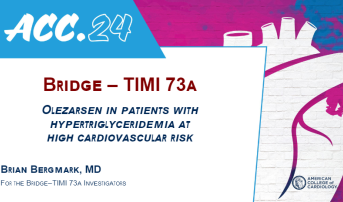Triglyceride-Lowering Therapies Provide Favorable Outcomes in Early Testing
In Bridge-TIMI 73a and SHASTA-2, the RNA-silencing therapies cut triglycerides quickly, offering hope for hard-to-treat patients.

ATLANTA, GA—Investigational agents that work by inhibiting apolipoprotein C-III (APOC3) are effective at reducing triglyceride levels, two phase IIb studies show.
In Bridge-TIMI 73a, treatment with olezarsen (Ionis Pharmaceuticals), an antisense oligonucleotide that targets APOC3 messenger RNA (mRNA), significantly reduced levels of triglycerides, apolipoprotein B (apoB), and non-HDL cholesterol in patients with moderate hypertriglyceridemia and increased cardiovascular risk and also in patients with severe hypertriglyceridemia alone.
And in SHASTA-2, the administration of plozasiran (Arrowhead Pharmaceuticals), a small-interfering RNA (siRNA) that degrades mRNA coding for APOC3, significantly slashed triglyceride levels in patients with severe hypertriglyceridemia.
The trials, which were presented this week at the American College of Cardiology 2024 Scientific Session, showed that the therapies were well tolerated and provide some optimism for a difficult-to-treat patient group, say experts.
“Reducing triglyceride-rich lipoproteins remains an unmet clinical need,” said Brian Bergmark, MD (Brigham and Women’s Hospital, Boston, MA), lead investigator of Bridge-TIMI 73a, during the late-breaking clinical trials session. “Elevated triglyceride-rich lipoproteins, such as chylomicrons and vLDL, are associated with heightened cardiovascular risk, and triglyceride-rich lipoproteins are thought to be at least as atherogenic as LDL cholesterol.”
Daniel Soffer, MD (University of Pennsylvania School of Medicine, Philadelphia), the discussant following Bergmark’s presentation, said it’s an “exciting time” when it comes to treatment for a population with no good options despite their residual atherosclerotic cardiovascular disease (ASCVD) risk. While lowering triglycerides is an effective therapy to mitigate the risk of acute pancreatitis, he questioned if doing so influences ASCVD outcomes, ultimately wondering why the Bridge-TIMI 73a investigators did not focus on non-HDL cholesterol and apoB as the primary endpoint.
Reducing triglyceride-rich lipoproteins remains an unmet clinical need. Brian Bergmark
Bergmark, in response, said that patients with elevated triglycerides are a heterogeneous group, with the elevated triglycerides being “clinically impactful” in some, such as those with rare genetic syndromes. Even in the broadest population, those with moderate triglycerides, there remains residual ASCVD risk associated with triglyceride-rich lipoproteins.
“A large part of the clinical benefit for a drug like this is bringing triglyceride levels down to degrees not currently available,” he said. “If we’re also better able to understand the cardiovascular risk reduction potential, there’s a lot of promise in that.”
As a clinician in a lipid clinic, Neha Pagidipati, MD (Duke University School of Medicine, Durham, NC), agreed that the patient with elevated triglycerides remains one of the most challenging to treat. Having two potential therapies is exciting, she added, but cautioned it’s still unknown if the drug can lower the risk of ASCVD. “We need to see what happens with clinical outcomes, not just pancreatitis,” she said during a press conference.
‘Rapid and Sustained’ Reductions
Lipoprotein lipase hydrolyzes triglycerides and is responsible for facilitating the clearance of triglyceride-rich lipoproteins. However, APOC3, which is synthesized in the liver, resides on these triglyceride-rich lipoprotein particles and inhibits lipoprotein lipase, resulting in increased triglyceride levels. There are genetic data showing that loss-of-function mutations in APOC3 result in lower triglyceride levels and lower cardiovascular risk, said Bergmark.
In Bridge-TIMI 73a, a phase IIb study published in the New England Journal of Medicine, investigators assessed the safety and efficacy of olezarsen in 154 patients (median age 62 years; 42% women) with elevated triglycerides who were well treated with lipid-lowering therapy. Patients with moderate hypertriglyceridemia (150 to less than 500 mg/dL) and elevated cardiovascular risk or severe hypertriglyceridemia (≥ 500 mg/dL) were randomly assigned to two cohorts: olezarsen 50 mg or 80 mg, with both injections given subcutaneously every 4 weeks. Each cohort was then randomized 3:1 to active treatment or placebo for 6 months.
Both doses of olezarsen resulted in “rapid and sustained” drops in triglyceride levels, said Bergmark. The 50-mg dose reduced triglycerides 49.3% and the 80-mg dose lowered triglycerides by 53.1%, both significant reductions compared with placebo (P < 0.0001). The findings were consistent across subgroups, including in those with moderate and severe hypertriglyceridemia. For those with moderate hypertriglyceridemia at baseline, 85.7% to 93.3% had their triglycerides reduced to less than 150 mg/dL with the 50- and 80-mg doses, respectively.
Levels of APOC3, vLDL, and remnant cholesterol also were significantly reduced, as were levels of apoB and non-HDL-cholesterol levels, both of which are markers of atherogenic risk. HDL-cholesterol levels increased and there was no change in LDL-cholesterol levels. With respect to safety, there was no difference in treatment-emergent adverse events compared with placebo and no increased risk of serious adverse outcomes. Liver enzymes were slightly elevated, but not to any clinically meaningful degree, said Bergmark. Renal events and bleeding risks were similar as well.
Several other trials with olezarsen are underway, including the 1,300-patient ESSENCE-TIMI 73b study in a population similar to the one include in Bridge-TIMI 73a. That study will include a coronary CT angiography substudy to better understand the effect of the therapy on atherosclerosis. It’s also being tested in two other studies—CORE-TIMI 72a and CORE2-TIMI 72b—in patients with severe hypertriglyceridemia alone.
We need to see what happens with clinical outcomes, not just pancreatitis. Neha Pagidipati
In an editorial, Gerald Watts, MD, PhD (University of Western Australia, Perth), notes that patients with moderate hypertriglyceridemia should be treated at the moment with combination lipid-lowering therapy, including a high-intensity statin, to get LDL-cholesterol levels down to goal. Watts, however, said that current therapies are largely ineffective for severely elevated triglycerides. While olezarsen has been granted fast-track review by the US Food and Drug Administration for familial chylomicronemia syndrome, “use of olezarsen for moderate hypertriglyceridemia in high-risk patients whose LDL-cholesterol level is at goal would depend on the outcomes of trials with clinical endpoints,” he writes.
Increase in LDL Levels
In SHASTA-2 with plozasiran, which was published in JAMA Cardiology, investigators focused solely on patients with severe hypertriglyceridemia. The goal with treatment in these patients is to reduce triglycerides below the threshold that is associated with the risk of acute pancreatitis, which is less than 500 mg/dL, said lead investigator Daniel Gaudet, MD, PhD (University of Montreal, Canada).
In this phase IIb, dose-ranging study, 226 patients (mean age 55 years; 78% male) were randomized to plozasiran 10 mg, 25 mg, or 50 mg or to placebo for 48 weeks, receiving injections at baseline and 12 weeks. Mean triglyceride level at baseline was 897 mg/dL (median 660 mg/dL).
At all doses, plozasiran reduced APOC3 and triglyceride levels by approximately 70% compared with placebo by week 48, said Gaudet. The absolute reductions in triglycerides at week 24 with the 10, 25, and 50 mg doses were 560, 711, and 672 mg/dL, respectively. More than 90% of patients got their levels down to less than 500 mg/dL. Non-HDL-cholesterol and remnant-cholesterol levels also decreased, while HDL-cholesterol levels increased.
In general, this agent was safe. . . . Thrombocytopenia wasn’t an issue with plozasiran at all. Daniel Gaudet
“In general, this agent was safe,” said Gaudet. “When we use an APOC3 inhibitor now, we compare this to its ancestor volanesorsen, which was associated with thrombocytopenia, but thrombocytopenia wasn’t an issue with plozasiran at all.” There was, however, a “modest worsening” of glycemic control, specifically in the highest-dose group, and this led to one patient stopping treatment.
Pradeep Natarajan, MD (Massachusetts General Hospital, Boston, MA), the discussant for SHASTA-2 during the session, pointed out that it was 10 years ago when researchers first showed that APOC3 loss-of-function mutations led to lower triglycerides and lower coronary heart disease risk without altering LDL-cholesterol levels. In SHASTA-2, however, LDL levels increased with plozasiran, up 33% to 44% from baseline with the lowest and highest doses at week 48, noted Natarajan.
Gaudet said that while LDL-cholesterol levels increased, there was no change in levels of apoB, which is the critical component of atherogenic lipoprotein. Additionally, Gaudet explained that in those with naturally occurring elevated triglycerides based on variants in the APOC3 gene, the incidence of ischemic vascular disease is mostly driven by remnant cholesterol.
“I’m not saying LDL cholesterol is not important, it is, but remnants are as well,” he said. “If you treat patients with an APOC3 inhibitor, LDL cholesterol might increase, but it’s easy to manage by introducing a statin, or uptitrating a statin, or by using a PCSK9 inhibitor,” he said.
Michael O’Riordan is the Managing Editor for TCTMD. He completed his undergraduate degrees at Queen’s University in Kingston, ON, and…
Read Full BioSources
Bergmark BA, Marston NA, Prohaska TA, et al. Olezarsen for hypertriglyceridemia in patients at high cardiovascular risk. N Engl J Med. 2024;Epub ahead of print.
Watts GF. Shooting the messenger to treat hypertriglyceridemia. N Engl J Med. 2024;Epub ahead of print.
Gaudet D, Pall D, Watts GF, et al. Plozasiran (ARO-APOC3) for severe hypertriglyceridemia: the SHASTA-2 randomized clinical trial. JAMA Cardiol. 2024;Epub ahead of print.
Disclosures
- Bergmark reports consulting for Abbott Vascular, Abiomed, Bain Life Sciences, Bolt, Cardiovascular Systems, Endovascular Engineering, Philips, Shockwave Medical, and Spectrawave.
- Gaudet reports grants and/or honoraria from Alnylam, Amgen, Arrowhead, AstraZeneca, Boehringer Ingelheim, CRISPR Therapeutics, Dalcor Pharma, Eli Lilly, Esperion, Ionis, Kowa, Novartis, Pfizer, Regeneron, Sanofi, Ultragenyx, and Verve Therapeutics.
- Watts reports grants/contracts from Amgen, Arrowhead Pharmaceuticals, Novartis, and Silence Pharmaceuticals and travel support from Arrowhead Pharmaceuticals.






Comments